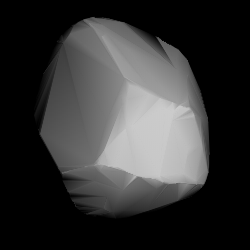 3D model based on lightcurve data | |
| Discovery | |
|---|---|
| Discovered by | J. Coggia |
| Discovery date | 30 August 1880 |
| Designations | |
| (217) Eudora | |
| Pronunciation | /juːˈdɔːrə/[1] |
Named after | Eudora |
| A880 QA, 1914 RA | |
| Main belt | |
| Orbital characteristics[2] | |
| Epoch 31 July 2016 (JD 2457600.5) | |
| Uncertainty parameter 0 | |
| Observation arc | 130.48 yr (47657 d) |
| Aphelion | 3.75541 AU (561.801 Gm) |
| Perihelion | 1.98080 AU (296.323 Gm) |
| 2.86811 AU (429.063 Gm) | |
| Eccentricity | 0.30937 |
| 4.86 yr (1774.2 d) | |
Average orbital speed | 17.57 km/s |
| 349.290° | |
| 0° 12m 10.49s / day | |
| Inclination | 10.5165° |
| 162.594° | |
| 155.320° | |
| Physical characteristics | |
| Dimensions | 66.24±2.3 km[2] 68.62 ± 1.41 km[3] |
| Mass | (1.52 ± 0.06) × 1018 kg[3] |
Mean density | 8.98 ± 0.65 g/cm3[3] |
| 25.272 h (1.0530 d)[2] 25.253 ± 0.003 hr[4] | |
| 0.0484±0.004 | |
| C | |
| 9.80 | |
217 Eudora is a large Main belt asteroid. It was discovered by French (Corsican) astronomer J. Coggia on August 30, 1880, in Marseilles, France. It was his fourth asteroid discovery and is named after Eudora, a Hyad in Greek mythology.
It probably has a composition similar to carbonaceous chondrites. In 2007, a study showed it rotates every 25.253 ± 0.003 hours, based on lightcurve data.[4] A light curve generated from photometric observations at Pulkovo Observatory, give a matching rotation period of 25.253 ± 0.002 hours and a brightness variation of 0.22 ± 0.04 in magnitude.[5]
- ^ Noah Webster (1884) A Practical Dictionary of the English Language
- ^ a b c "217 Eudora". JPL Small-Body Database. NASA/Jet Propulsion Laboratory. Retrieved 12 May 2016.
- ^ a b c Cite error: The named reference
Carry2012was invoked but never defined (see the help page). - ^ a b Cite error: The named reference
Buchheim2007was invoked but never defined (see the help page). - ^ Cite error: The named reference
Pilcher2011was invoked but never defined (see the help page).